Items
Tag
groundwater
-
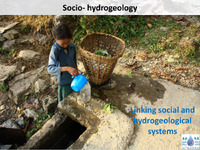 Socio - hydrogeology Linking social and hydrogeological systems The discussion highlights the critical link between groundwater and societal needs in India, where groundwater supplies 90% of rural drinking water and 70% of irrigation. Despite its importance, 60% of Indian districts face groundwater issues related to availability and quality. Key factors influencing groundwater development include technological advancements, land scarcity, and changing cropping patterns. Governance challenges arise from inadequate regulation and enforcement, while competition for groundwater often leads to local inequities rather than outright conflict. Effective management requires a coordinated approach that integrates social equity, economic efficiency, and sustainable practices to address groundwater as a common pool resource.
Socio - hydrogeology Linking social and hydrogeological systems The discussion highlights the critical link between groundwater and societal needs in India, where groundwater supplies 90% of rural drinking water and 70% of irrigation. Despite its importance, 60% of Indian districts face groundwater issues related to availability and quality. Key factors influencing groundwater development include technological advancements, land scarcity, and changing cropping patterns. Governance challenges arise from inadequate regulation and enforcement, while competition for groundwater often leads to local inequities rather than outright conflict. Effective management requires a coordinated approach that integrates social equity, economic efficiency, and sustainable practices to address groundwater as a common pool resource. -
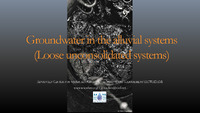 Groundwater in the alluvial systems Groundwater management in alluvial aquifer systems, particularly in regions like Neemrana, Rajasthan, presents challenges due to slow recharge and significant vulnerabilities. Effective water management strategies are essential, emphasizing the need for local governance to regulate groundwater use and implement best practices. In North Bihar, where 80% of water sources are groundwater-based, issues like drinking water scarcity and contamination during floods highlight the urgent need for improved sanitation and access to safe water. Reviving traditional water management systems and focusing on recharge structures near ridges can enhance groundwater sustainability in these areas.
Groundwater in the alluvial systems Groundwater management in alluvial aquifer systems, particularly in regions like Neemrana, Rajasthan, presents challenges due to slow recharge and significant vulnerabilities. Effective water management strategies are essential, emphasizing the need for local governance to regulate groundwater use and implement best practices. In North Bihar, where 80% of water sources are groundwater-based, issues like drinking water scarcity and contamination during floods highlight the urgent need for improved sanitation and access to safe water. Reviving traditional water management systems and focusing on recharge structures near ridges can enhance groundwater sustainability in these areas. -
 Introduction to springs The document discusses the significance of springs, particularly in India, highlighting their role as natural groundwater discharge points that sustain streams and rivers. It outlines the extensive presence of springs across various regions, including the Himalayas and Western Ghats, and notes the lack of comprehensive data on groundwater resources. Springs are categorized into different types based on their formation processes, such as depression, fracture, and karst springs. The text emphasizes the need to shift focus from viewing groundwater merely as a source to understanding it as a vital resource, advocating for improved monitoring and management practices to ensure water quality and availability.
Introduction to springs The document discusses the significance of springs, particularly in India, highlighting their role as natural groundwater discharge points that sustain streams and rivers. It outlines the extensive presence of springs across various regions, including the Himalayas and Western Ghats, and notes the lack of comprehensive data on groundwater resources. Springs are categorized into different types based on their formation processes, such as depression, fracture, and karst springs. The text emphasizes the need to shift focus from viewing groundwater merely as a source to understanding it as a vital resource, advocating for improved monitoring and management practices to ensure water quality and availability. -
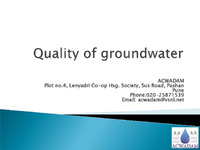 Quality of Ground Water Access to safe drinking water is a fundamental human right, yet in India, groundwater, which supplies 90% of rural and over 45% of urban water, often suffers from quality issues due to overexploitation and industrial contamination. Many districts report high levels of harmful substances like fluoride and arsenic, affecting millions with water-borne diseases and health risks. Groundwater quality varies based on geological factors and human activities, necessitating regular sampling and analysis to monitor safety. Improved community awareness, traditional purification methods, and sustainable management practices are essential for enhancing water quality and ensuring public health.
Quality of Ground Water Access to safe drinking water is a fundamental human right, yet in India, groundwater, which supplies 90% of rural and over 45% of urban water, often suffers from quality issues due to overexploitation and industrial contamination. Many districts report high levels of harmful substances like fluoride and arsenic, affecting millions with water-borne diseases and health risks. Groundwater quality varies based on geological factors and human activities, necessitating regular sampling and analysis to monitor safety. Improved community awareness, traditional purification methods, and sustainable management practices are essential for enhancing water quality and ensuring public health. -
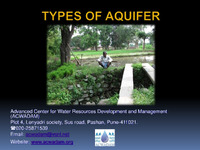 Types of aquifer An aquifer is a rock formation that stores water and can release it for use, functioning as an underground reservoir. There are two main types: unconfined aquifers, which are directly connected to the atmosphere and fluctuate in water levels due to recharge and discharge, and confined aquifers, which are surrounded by impermeable layers and maintain water under pressure. Water can flow from unconfined aquifers to the surface, creating springs, while base flow from these aquifers contributes to stream flow, especially during dry seasons. Perched aquifers are small, limited extensions of unconfined aquifers, retaining groundwater above an impermeable layer.
Types of aquifer An aquifer is a rock formation that stores water and can release it for use, functioning as an underground reservoir. There are two main types: unconfined aquifers, which are directly connected to the atmosphere and fluctuate in water levels due to recharge and discharge, and confined aquifers, which are surrounded by impermeable layers and maintain water under pressure. Water can flow from unconfined aquifers to the surface, creating springs, while base flow from these aquifers contributes to stream flow, especially during dry seasons. Perched aquifers are small, limited extensions of unconfined aquifers, retaining groundwater above an impermeable layer. -
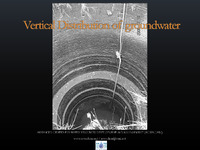 Vertical Distribution of Groundwater Groundwater is distributed in subsurface zones with varying characteristics. The zone of rock fracture contains openings that can hold water, while below it, the dense rock zone has limited water capacity. The zone of aeration is partially filled with air and water, supporting vegetation, while the zone of saturation is fully water-saturated, with the water table marking its upper boundary. This saturated zone can be accessed through wells, which reveal groundwater levels. Vadose hydrology, occurring above the water table, plays a crucial role in managing water transfer between surface and groundwater, influencing factors like precipitation and moisture management.
Vertical Distribution of Groundwater Groundwater is distributed in subsurface zones with varying characteristics. The zone of rock fracture contains openings that can hold water, while below it, the dense rock zone has limited water capacity. The zone of aeration is partially filled with air and water, supporting vegetation, while the zone of saturation is fully water-saturated, with the water table marking its upper boundary. This saturated zone can be accessed through wells, which reveal groundwater levels. Vadose hydrology, occurring above the water table, plays a crucial role in managing water transfer between surface and groundwater, influencing factors like precipitation and moisture management. -
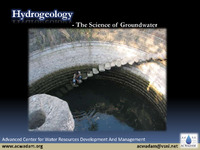 Hydrogeology - The Science of Groundwater Hydrogeology is the scientific study of groundwater, focusing on how water moves through geological formations, primarily rocks. Groundwater is a crucial resource, being the largest source of fresh water globally, supplying 85% of rural and 50% of urban water needs. It often exists beneath the surface and can be accessed easily, even in residential areas. This resource acts as a natural filtration system, typically maintaining good quality and stable temperatures. However, groundwater is fragile and sensitive to overuse and contamination, making it essential to understand its properties and distribution through scientific study.
Hydrogeology - The Science of Groundwater Hydrogeology is the scientific study of groundwater, focusing on how water moves through geological formations, primarily rocks. Groundwater is a crucial resource, being the largest source of fresh water globally, supplying 85% of rural and 50% of urban water needs. It often exists beneath the surface and can be accessed easily, even in residential areas. This resource acts as a natural filtration system, typically maintaining good quality and stable temperatures. However, groundwater is fragile and sensitive to overuse and contamination, making it essential to understand its properties and distribution through scientific study. -
 The Rock Structure The study of rock structure encompasses the texture, which describes the size, shape, and arrangement of grains in rocks, particularly sedimentary types that exhibit clastic texture. Structural geology focuses on the three-dimensional arrangement of rock units and their deformation history, revealing how rocks respond to various stress types like tension, compression, and shear. Key features include folds, faults, and joints, with folds representing bends from plastic deformation, while faults are fractures where rock movement occurs. Additionally, joints are weaknesses in rocks that can influence fluid movement and mineral formation. Unconformities signify gaps in geological records, indicating non-continuous sediment deposition. Overall, the characteristics of rocks affect groundwater movement and storage.
The Rock Structure The study of rock structure encompasses the texture, which describes the size, shape, and arrangement of grains in rocks, particularly sedimentary types that exhibit clastic texture. Structural geology focuses on the three-dimensional arrangement of rock units and their deformation history, revealing how rocks respond to various stress types like tension, compression, and shear. Key features include folds, faults, and joints, with folds representing bends from plastic deformation, while faults are fractures where rock movement occurs. Additionally, joints are weaknesses in rocks that can influence fluid movement and mineral formation. Unconformities signify gaps in geological records, indicating non-continuous sediment deposition. Overall, the characteristics of rocks affect groundwater movement and storage. -
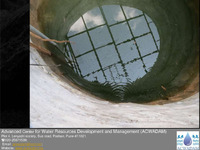 Introduction - Importance of Groundwater Groundwater is a crucial resource, providing 90% of rural water supply and supporting 61% of irrigation in India, highlighting its importance in agriculture and domestic use. With over 30 million irrigation wells, India is the largest global user of groundwater for farming. However, nearly 60% of districts face groundwater vulnerability due to over-extraction and quality issues. ACWADAM aims to promote sustainable groundwater management through research, training, and collaboration, addressing challenges in both rural and urban settings. Their efforts focus on developing effective management models and educating diverse audiences on groundwater issues.
Introduction - Importance of Groundwater Groundwater is a crucial resource, providing 90% of rural water supply and supporting 61% of irrigation in India, highlighting its importance in agriculture and domestic use. With over 30 million irrigation wells, India is the largest global user of groundwater for farming. However, nearly 60% of districts face groundwater vulnerability due to over-extraction and quality issues. ACWADAM aims to promote sustainable groundwater management through research, training, and collaboration, addressing challenges in both rural and urban settings. Their efforts focus on developing effective management models and educating diverse audiences on groundwater issues.
